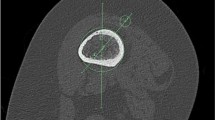Abstract
Purpose
The purpose of this study was to determine the diagnostic value of the flexion abduction external rotation (FABER) distance test (FDT) for the diagnosis of cam-type femoroacetabular impingement (FAI) as defined by alpha angle.
Methods
For this study, 603 patients with symptomatic, unilateral femoroacetabular impingement were included. Patients with symptoms of hip instability, bilateral symptoms, bilateral surgery, or bilateral alpha angles over 55 were excluded from the analysis. A positive FDT was defined as a difference of 4 cm or more between hips. A pathological cam was defined as an alpha angle of 78° or greater.
Results
The average age was 36.4 ± 12 years, with 344 males and 259 females. Faber distance of the injured hip was correlated with age at surgery (rho = 0.148; p < 0.001). Alpha angle on the injured hip was positively correlated with injured hip FABER distance (rho = 0.276; p < 0.001). The average alpha angle in patients with a positive FABER distance test was 74° (SD = 11°) compared to 68° (SD = 8°) in patients with a negative distance test (p = 0.001). The sensitivity of the FDT to diagnose pathological cam was 0.848 (0.79–0.89) with a negative predictive value of 86% (81–90%).
Conclusion
This study demonstrated that the FABER distance test is correlated with the alpha angle and is a good diagnostic exam for pathological cam-type FAI as defined by and alpha angle equal to or greater than 78°.
Clinical relevance
FABER distance test is a simple test that can be used as a screening test to decide if FAI should be suspected and further testing is needed.
Level of evidence
III.
Similar content being viewed by others
References
Agricola R, Waarsing JH, Thomas GE, Carr AJ, Reijman M, Bierma-Zeinstra SM, Glyn-Jones S, Weinans H, Arden NK (2014) Cam impingement: defining the presence of a cam deformity by the alpha angle: data from the CHECK cohort and Chingford cohort. Osteoarthr Cartil 22(2):218–225
Bagwell JJ, Bauer L, Gradoz M, Grindstaff TL (2016) The reliability of FABER test hip range of motion measurements. Int J Sports Phys Ther 11(7):1101–1105
Barrientos C, Barahona M, Diaz J, Branes J, Chaparro F, Hinspeter J (2016) Is there a pathological alpha angle for hip impingement? A diagnostic test study. J Hip Preserv Surg 3(3):223–228
Beck M, Kalhor M, Leunig M, Ganz R (2005) Hip morphology influences the pattern of damage to the acetabular cartilage: femoroacetabular impingement as a cause of early osteoarthritis of the hip. J Bone Jt Surg Br 87(7):1012–1018
Braly BA, Beall DP, Martin HD (2006) Clinical examination of the athletic hip. Clin Sports Med 25(2):199–210
Ganz R, Parvizi J, Beck M, Leunig M, Notzil H, Siebenrock KA (2003) Femoroacetabular impingement: a cause for osteoarthritis of the hip. Clin Orthop Relat Res 417:112–120
Haldane CE, Ekhtiari S, de Sa D, Simunovic N, Ayeni OR (2017) Preoperative physical examination and imaging of femoroacetabular impingement prior to hip arthroscopy—a systematic review. J Hip Preserv Surg 4(3):201–213
Johnston TL, Schenker ML, Briggs KK, Philippon MJ (2008) Relationship between offset angle alpha and hip chondral injury in femoroacetabular impingement. Arthroscopy 24(6):669–675
Larson CM, Safran MR, Brcka DA, Vaughn ZD, Giveans MR, Stone RM (2018) Predictors of clinically suspected intra-articular hip symptoms and prevalence of hip pathomorphologies presenting to sports medicine and hip preservation orthopaedic surgeons. Arthroscopy 34(3):825–831
Maslowski E, Sullivan W, Forster Harwood J, Gonzalez P, Kaufman M, Vidal A, Akuthota V (2010) The diagnostic validity of hip provocation maneuvers to detect intra-articular hip pathology. PMR 2(3):174–181
Philippon MJ, Ho CP, Briggs KK, Stull J, LaPrade RF (2013) Prevalence of increased alpha angles as a measure of cam-type femoroacetabular impingement in youth ice hockey players. Am J Sports Med 41(6):1357–1362
Philippon MJ, Maxwell RB, Johnston TL, Schenker M, Briggs KK (2007) Clinical presentation of femoroacetabular impingement. Knee Surg Sports Traumatol Arthrosc 15(8):1041–1047
Philippon MJ, Weiss DR, Kuppersmith DA, Briggs KK, Hay CJ (2010) Arthroscopic labral repair and treatment of femoroacetabular impingement in professional hockey players. Am J Sports Med 38(1):99–104
Reiman MP, Goode AP, Cook CE, Holmich P, Throborg K (2015) Diagnostic accuracy of clinical tests for the diagnosis of hip femoroacetabular impingement/labral tear: a systematic review with meta-analysis. Br J Sports Med 49(12):811
Rosner B (2006) Fundamentals of biostatistics, 6th edn. Thomson Brooks/Cole, Duxbury
Scopp JM, Moorman CT III (2001) The assessment of athletic hip injury. Clin Sports Med 20(4):647–659
Tijssen M, van Cingel R, Willemsen L, de Visser E (2012) Diagnostics of femoroacetabular impingement and labral pathology of the hip: a systematic review of the accuracy and validity of physical tests. Arthroscopy 28(6):860–871
Vad VB, Bhat AL, Basrai D, Gebeh A, Aspergren DD, Andrews JR (2004) Low back pain in professional golfers. The role of associated hip and low back range-of-motion deficits. Am J Sports Med 32(2):494–497
Funding
No outside funding was provided for this study.
Author information
Authors and Affiliations
Corresponding author
Ethics declarations
Conflict of interest
Board member/owner/officer/committee appointments: Arthrocare (MJP), ISHA (MJP). Royalties: Arthrocare, DonJoy, Bledsoe, Linvatec (MJP), Vail Valley Surgery Center. Paid consultant or employee: Smith & Nephew (MJP). Research or institutional support from companies: Smith & Nephew, Ossur, Arthrex, Siemens, Vail Valley Medical Center (MJP).
Ethical approval
This study was IRB approved by the Vail Valley Medical Center IIRB under IRB protocol #2002-03.
Rights and permissions
About this article
Cite this article
Trindade, C.A.C., Briggs, K.K., Fagotti, L. et al. Positive FABER distance test is associated with higher alpha angle in symptomatic patients. Knee Surg Sports Traumatol Arthrosc 27, 3158–3161 (2019). https://doi.org/10.1007/s00167-018-5031-2
Received:
Accepted:
Published:
Issue Date:
DOI: https://doi.org/10.1007/s00167-018-5031-2




